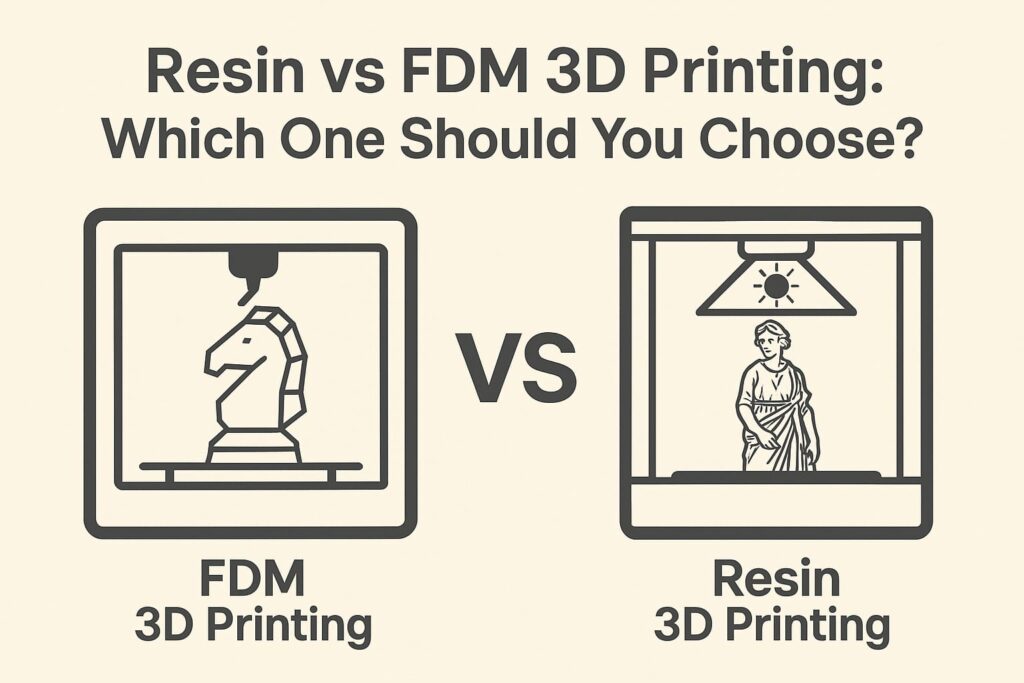
- +91 8055996347
- info@3dreality.in
- Chapru nagar square, CA road, Nagpur, Maharashtra-440008

3D printing has revolutionized the way we create, prototype, and bring ideas to life. Whether you’re a hobbyist, an entrepreneur, or just someone curious about the possibilities of this technology, you’ve probably come across two major types of 3D printing: FDM and Resin.
Now comes the million-dollar question: Which one is right for you?
In this blog, we’ll break down what makes each method unique, highlight their pros and cons, and help you figure out which one suits your goals best—without drowning you in technical jargon.
FDM, or Fused Deposition Modeling, is the most common type of 3D printing out there. It works by melting a plastic filament (think of it like a spaghetti string) and layering it one thin strip at a time to create a physical object.
TPU (rubber-like flexibility)
Everyday gadgets
FDM printers are generally more affordable and beginner-friendly. If you’ve ever seen a 3D printer in a school, maker space, or someone’s garage—chances are it was FDM.
Resin printing, often referred to as SLA (Stereolithography), DLP, or LCD printing, uses a UV light to cure liquid resin into hardened plastic—layer by layer.
Resin printers are known for exceptional detail and smooth finishes. But they come with a bit more hassle—cleaning, curing, and handling chemicals safely.
Let’s compare these two side-by-side in the ways that matter most:
| Feature | FDM Printing | Resin Printing |
|---|---|---|
| Print Quality | Moderate (visible layer lines) | High (sharp details, smooth finish) |
| Material Strength | Durable and tough | Brittle (unless using special resins) |
| Ease of Use | Beginner-friendly, plug-and-play | Learning curve, messy handling |
| Cost | Budget-friendly (lower material and printer cost) | Resin is costlier; post-processing adds up |
| Maintenance | Low maintenance | Regular cleaning and resin handling needed |
| Safety | Safe with minimal precautions | Needs gloves, masks, and proper ventilation |
| Print Size | Larger build volumes available | Smaller print area (unless using high-end models) |
| Post-Processing | Basic (remove support, sand if needed) | Intensive (wash in alcohol, UV curing) |
Go for FDM if you:
FDM is great for people who want quick, strong prints without the mess. It’s perfect for prototypes, engineering parts, or DIY gadgets.
Choose Resin if you:
Resin printing shines (literally) when you need precision. If your goal is show-stopping visuals over rugged durability, resin’s your best bet.
Both FDM and Resin 3D printing have their strengths. It’s not about which is better overall, but which is better for you.
If you’re printing cosplay props or prototypes? FDM is your best friend.
If you’re crafting detailed miniatures or jewelry? Resin will blow your mind.
Still can’t decide? Honestly, many makers end up owning both types of printers. FDM for big, strong prints. Resin for the beautiful, tiny ones.
Got questions about choosing a 3D printer? Or looking to get your designs printed without buying a machine?
We’re happy to help—just reach out!